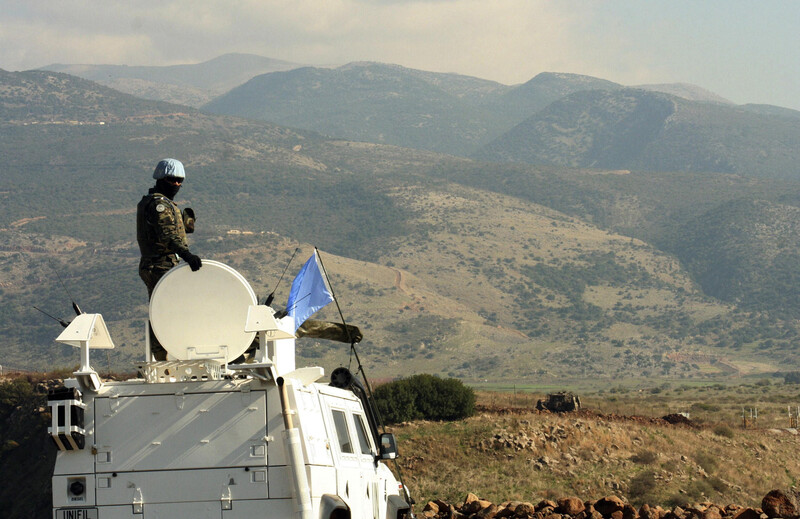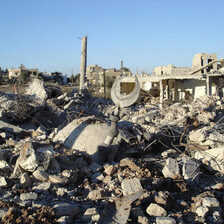The Electronic Intifada Beirut 24 May 2013

Israel’s daily violations of Lebanese sovereignty are ignored in the Western press.
ReutersRecently there has been a sound coming from the skies over Beirut triggering unpleasant recollections: the distant roar of Israeli fighter jets as one lies in bed at night.
This noise brings with it images and memories from the last war Israel waged on Lebanon, the 33-day war during the summer of 2006. Even as I write this from my office near the center of the city, the ominous rumbling of Israeli fighter jets, announcing their illegal incursions into Lebanese airspace, can be heard over the capital.
But this threatening behavior above Lebanon is non-existent, or so the Western media corporations would have us believe. While information-sharing web tools have broken the mainstream media’s monopoly over covering and analyzing world developments, there is still a long way to go. The Israeli politics of dispossession enjoy near unconditional support in the editorial rooms of New York, London and Paris, a bias still undetected by most of the Western audience they claim to serve.
On 25 April, these editors saw to it that one story dominated the front pages: reports of an alleged unmanned aerial vehicle (UAV), or drone, that flew from Lebanon to historic Palestine, with accompanying reportage and commentary treating information given by Israeli government and military sources as the definitive truth of the incident.
The Israeli Air Force said it shot down a UAV several miles off the coast of the northern city of Haifa after it entered Israeli airspace from Lebanon. Israel’s deputy defense minister Danny Danon accused Hizballah of sending the drone: “We’re talking about another attempt by Hizballah to send an unmanned drone into Israeli territory,” he told army radio (“Israel shoots down Lebanese drone,” DefenseNews, 25 April 2013).
Shortly after the Israeli announcement, Hizballah issued a statement denying this was the case (“Hezbollah denies responsibility for drone shot down by Israel,” Al-Akhbar English, 26 April 2013).
This is in contrast to October last year, when Israel said it had shot down a drone over the Negev (Naqab). In that case, Hizballah proudly claimed the drone as its own and celebrated this demonstration of its technological prowess (“Hezbollah admits launching drone over Israel,” BBC).
For its part, a spokesperson with the United Nations Interim Force in Lebanon (UNIFIL) announced after the Israeli statement on 25 April: “We learned from the media that the Israeli Air Force has shot down a drone and we’re investigating these reports.”
As part of its peacekeeping mandate, UNIFIL has radars along the coast to monitor Lebanon’s entire airspace, and a few hours later UNIFIL spokesperson Andrea Tenenti said the UN force could not confirm that a drone had flown from its area of operations in southern Lebanon (“Israel shoots down drone off Haifa, Hizbullah denies responsibility,” Naharnet, 25 April 2013).
Inconvenient facts
So Hizballah denied responsibility and the UNIFIL couldn’t confirm that a drone flew over south Lebanon into Israeli-controlled airspace, but far be it for these inconvenient facts to get in the way of a good story. This newest threat to Israel burned like wildfire across the pages of major Western media outlets like The Los Angeles Times, The Washington Post, France 24, The Daily Telegraph and the BBC, which dutifully reported the worries over Israel’s security being breached.
Poor Israel: one of the strongest armies in the world, sitting on a nuclear arsenal.
These news reports demonstrate the systematic bias of Western corporate media when it comes to Israel. While the reports all spoke of Hizballah’s violation of Israel’s “borders” and sovereignty and the threat this posed to Israeli civilians, none mentioned the daily Israeli violations of Lebanon’s sovereignty and the threat this poses to Lebanese citizens. Without this, a reader might easily mistake the aggressor for the victim.
Then there was the one-sided sourcing of “facts” to back up the story and the rush to judgment. On 26 April — the day after the alleged drone was downed — the Israeli government itself began to shift its narrative to more ambiguous finger-pointing at Iran, rather than directly blaming Hizballah (“Israel points finger at Iran over drone from Lebanon,” The Daily Telegraph, 27 April 2013).
Meanwhile, a 8 May story in Lebanon’s daily As-Safir newspaper claims it was actually an Israeli drone that had been intercepted by resistance fighters en route to Lebanon.
According to unnamed sources close to Hizballah and Western diplomatic circles cited by the paper, when the Israeli Air Force noticed that its UAV was out of its control, it shot it down over the Mediterranean. This suggestion seems at least plausible when stacked next to the UNIFIL report and Hizballah’s denial.
But taking this into account or following up on it would have required understanding Arabic, which few foreign journalists do.
Daily terror
Israel inflicts different methods of terror on Lebanon daily: F-16s and F-15s stage mock raids and drones stalk our skies — all in violation of UN resolution 1701. Lebanese citizens are kidnapped near the border, Israeli landmines and cluster bombs continue to await their victims on Lebanese soil, not to mention the Israeli army’s continued occupation of parts of Lebanon.
While the UN occasionally condemns these acts of Israeli aggression, the fact that they continue unabated reminds us in Lebanon that accountability and international law end at our southern border. So too does objective journalism, it seems, given that in the past month Israeli violations of Lebanese airspace have heavily intensified, but none of this has made it into the Western press.
As a journalist, I’ve tried to pitch stories to mainstream media outlets on the constant Israeli violations of Lebanese sovereignty and have been lucky enough, from time to time, for an editor to bother to reply, if only to say that the story is irrelevant.
The adage goes that real journalism is publishing what someone else does not want printed; everything else is public relations. By publishing Israel’s claims as fact, and ignoring the reality on the ground in Lebanon and Palestine, mainstream journalists show how well practiced they are in the art of PR.
Moe Ali Nayel is a freelance journalist based in Beirut, Lebanon. Follow him on Twitter: @MoeAliN.





Comments
Why indeed?
Permalink Brenda Heard replied on
Thank you, Moe, for bringing attention to these issues. Friends of Lebanon (London) has also been working to highlight the double standards on so many levels. Here's a link to an article that explores this topic and offers documented statistics: http://friendsoflebanon.org/ar... "Birds of Prey: the Record of Impunity for Israeli Military Aircraft."
Interesting points but the
Permalink Mmm replied on
Interesting points but the sub-head "Daily Terror" is completely overdramatic. Yes there are drones in Lebanon (I live in Beirut) but people are not living in constant fear of being attacked. But apart from that, good work.
media double standard
Permalink John el-amin replied on
Bravo ! However, racist double standard would be more apt.
As an African American living in the
American South, the method and techniques of fostering lies and establishing a public appetite for supporting the status quo, is apparent in the bogus reporting of the Zionist controlled and racist orientented media outlets.
Your work is a like striking a blow for truth.
The desperation of Zionists and their counterparts will not overcome truth.
Evil has never triumphed over good.
Please continue your efforts to bring the facts to the world.
John El-Amin, you are an anti-semite
Permalink Lorrie Hazelwood replied on
Whenever people complain that the media is controlled by the "zionists" this is an obvious code word for racist attitudes towards the Jews. If you want your comments to have any legitimacy, or even a thin veneer of legitimacy, you should tone down your racist hate rhetoric.